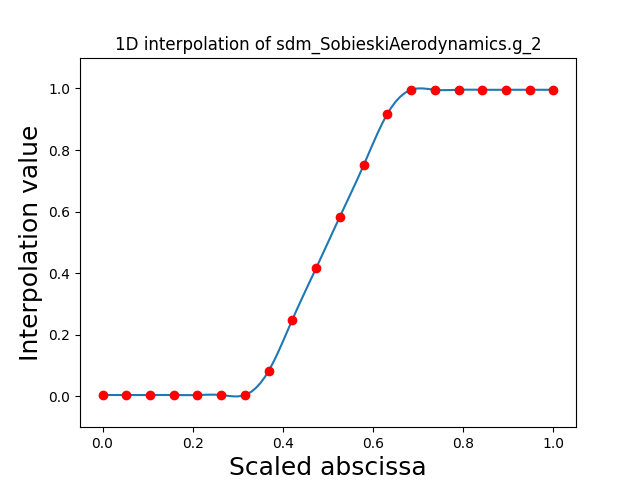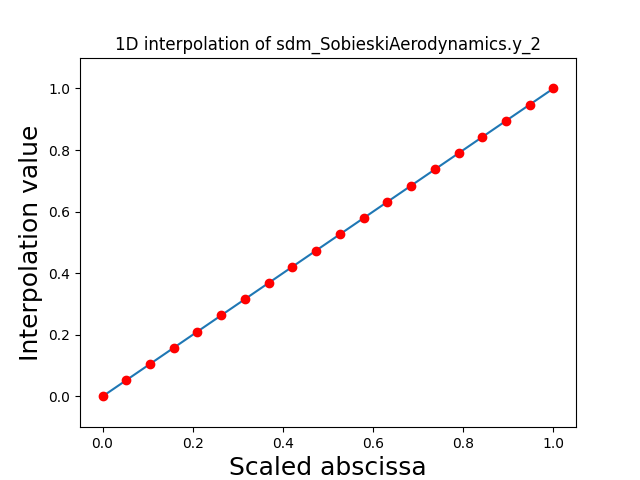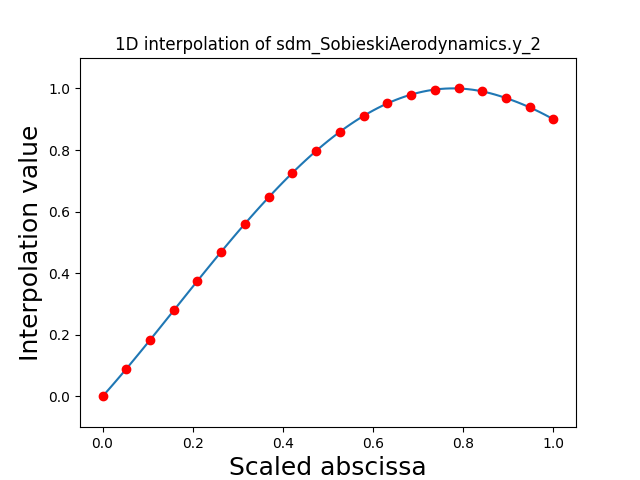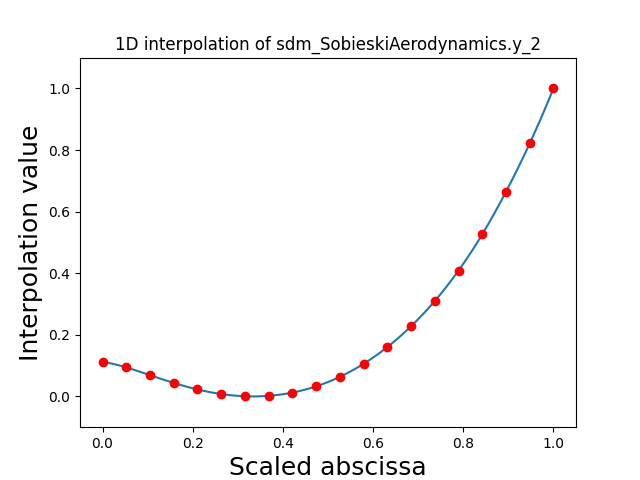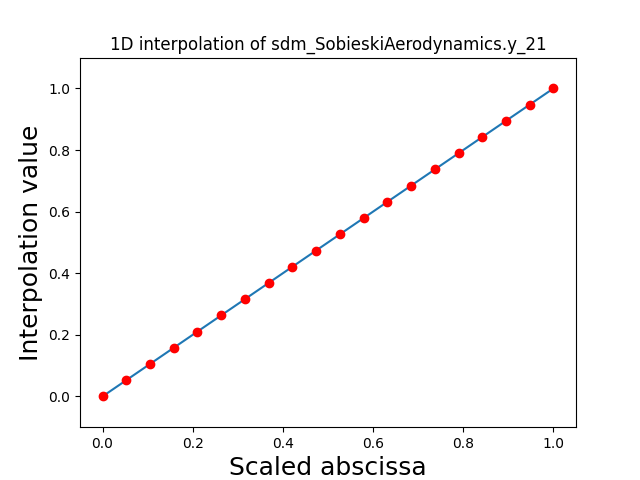Note
Click here to download the full example code
Scalable diagonal discipline¶
Let us consider the SobieskiAerodynamics discipline.
We want to build its ScalableDiscipline counterpart,
using a ScalableDiagonalModel
For that, we can use a 20-length DiagonalDOE
and test different sizes of variables or different settings
for the scalable diagonal discipline.
from __future__ import absolute_import, division, unicode_literals
from future import standard_library
Import¶
from gemseo.api import (
configure_logger,
create_discipline,
create_scalable,
create_scenario,
)
from gemseo.problems.sobieski.core import SobieskiProblem
configure_logger()
standard_library.install_aliases()
Learning dataset¶
The first step is to build an AbstractFullCache dataset
from a DiagonalDOE.
Instantiate the discipline¶
For that, we instantiate the SobieskiAerodynamics discipline
and set it up to cache all evaluations.
discipline = create_discipline("SobieskiAerodynamics")
discipline.set_cache_policy(discipline.MEMORY_FULL_CACHE)
Get the input space¶
We also define the input space on which to sample the discipline.
input_space = SobieskiProblem().read_design_space()
input_space.filter(discipline.get_input_data_names())
Out:
<gemseo.algos.design_space.DesignSpace object at 0x7fc29db32ac0>
Build the DOE scenario¶
Lastly, we sample the discipline by means of a DOEScenario
relying on both discipline and input space.
In order to build a diagonal scalable discipline,
a DiagonalDOE must be used.
scenario = create_scenario(
[discipline], "DisciplinaryOpt", "y_2", input_space, scenario_type="DOE"
)
scenario.execute({"algo": "DiagonalDOE", "n_samples": 20})
Out:
{'eval_jac': False, 'algo': 'DiagonalDOE', 'n_samples': 20}
Scalable diagonal discipline¶
Build the scalable discipline¶
The second step is to build a ScalableDiscipline,
using a ScalableDiagonalModel and the cache of the discipline.
scalable = create_scalable("ScalableDiagonalModel", discipline.cache)
Visualize the input-output dependencies¶
We can easily access the underlying ScalableDiagonalModel
and plot the corresponding input-output dependency matrix
where the level of gray and the number (in [0,100]) represent
the degree of dependency between inputs and outputs.
Input are on the left while outputs are at the top.
More precisely, for a given output component located at the top of the graph,
these degrees are contributions to the output component and they add up to 1.
In other words, a degree expresses this contribution in percentage
and for a given column, the elements add up to 100.
scalable.scalable_model.plot_dependency(save=False, show=True)
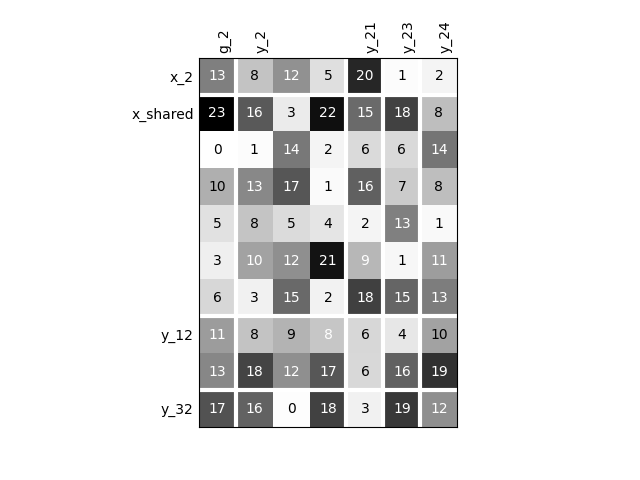
Visualize the 1D interpolations¶
For every output, we can also visualize a spline interpolation of the output samples over the diagonal of the input space.
scalable.scalable_model.plot_1d_interpolations(save=False, show=True)
Out:
[]
Increased problem dimension¶
We can repeat the construction of the scalable discipline for different sizes of variables and visualize the input-output dependency matrices.
Twice as many inputs¶
For example, we can increase the size of each input by a factor of 2.
sizes = {
name: discipline.cache.varsizes[name] * 2
for name in discipline.get_input_data_names()
}
scalable = create_scalable("ScalableDiagonalModel", discipline.cache, sizes)
scalable.scalable_model.plot_dependency(save=False, show=True)

Twice as many outputs¶
Or we can increase the size of each output by a factor of 2.
sizes = {
name: discipline.cache.varsizes[name] * 2
for name in discipline.get_output_data_names()
}
scalable = create_scalable("ScalableDiagonalModel", discipline.cache, sizes)
scalable.scalable_model.plot_dependency(save=False, show=True)
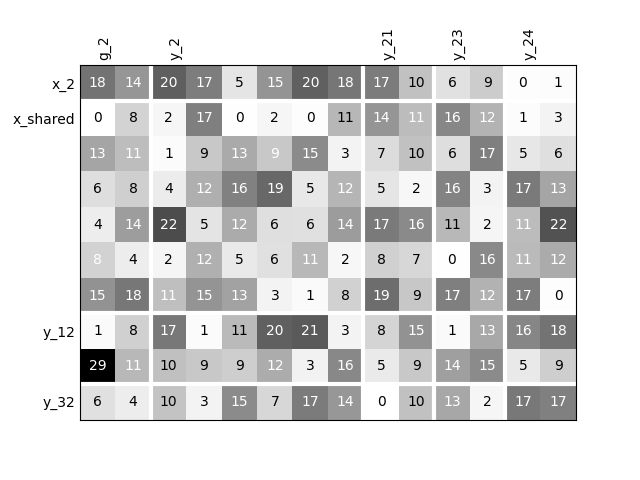
Twice as many variables¶
Or we can increase the size of each input and each output by a factor of 2.
names = list(discipline.get_input_data_names())
names += list(discipline.get_output_data_names())
sizes = {name: discipline.cache.varsizes[name] * 2 for name in names}
scalable = create_scalable("ScalableDiagonalModel", discipline.cache, sizes)
scalable.scalable_model.plot_dependency(save=False, show=True)
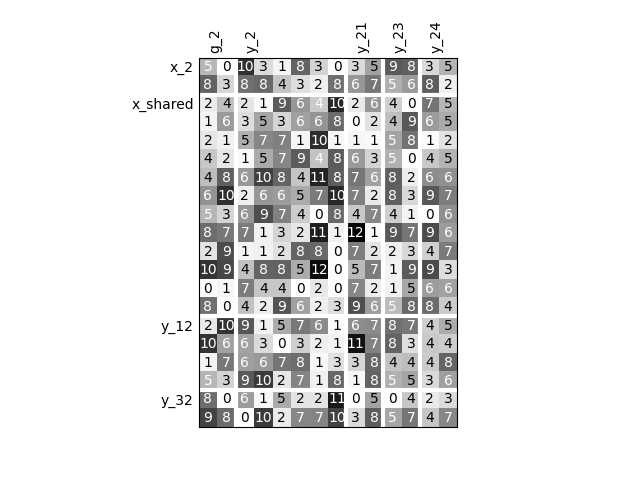
Binary IO dependencies¶
By default, any output component depends on any input component with a random level. We can also consider sparser input-output dependency by means of binary input-output dependency matrices. For that, we have to set the value of the fill factor which represents the part of connection between inputs and outputs. Then, a connection is represented by a black square while an absence of connection is presented by a white one. When the fill factor is equal to 1, any input is connected to any output. Conversely, when the fill factor is equal to 0, there is not a single connection between inputs and outputs.
Fill factor = 0.2¶
Here, there is a 20% connection rate
scalable = create_scalable(
"ScalableDiagonalModel", discipline.cache, sizes, fill_factor=0.2
)
scalable.scalable_model.plot_dependency(save=False, show=True)

Fill factor = 0.5¶
Here, there is a 50% connection rate
scalable = create_scalable(
"ScalableDiagonalModel", discipline.cache, sizes, fill_factor=0.5
)
scalable.scalable_model.plot_dependency(save=False, show=True)
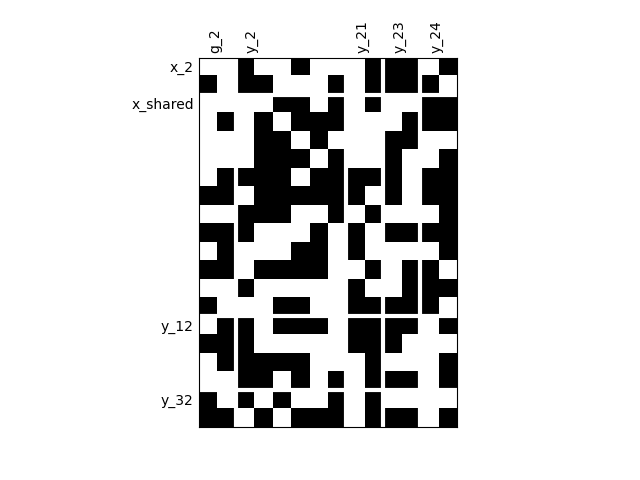
Fill factor = 0.8¶
Here, there is a 80% connection rate
scalable = create_scalable(
"ScalableDiagonalModel", discipline.cache, sizes, fill_factor=0.8
)
scalable.scalable_model.plot_dependency(save=False, show=True)

Heterogeneous dependencies¶
We could also imagine a more complex situation
where an output would depend inputs with a particular fill factor.
For example, let us consider a 20% connection rate for "y_2".
scalable = create_scalable(
"ScalableDiagonalModel", discipline.cache, sizes, fill_factor={"y_2": 0.2}
)
scalable.scalable_model.plot_dependency(save=False, show=True)
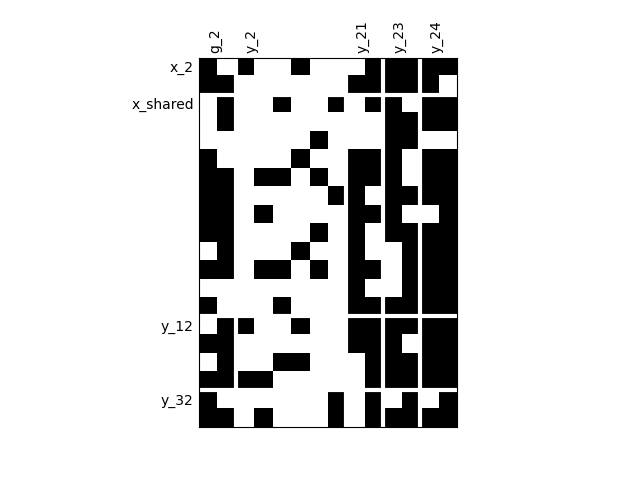
Group dependencies¶
We could also imagine another particular situation
where an output would depend only on certain inputs.
For example, let us suppose that "y_2" depends only on "x_shared".
scalable = create_scalable(
"ScalableDiagonalModel", discipline.cache, sizes, group_dep={"y_2": ["x_shared"]}
)
scalable.scalable_model.plot_dependency(save=False, show=True)
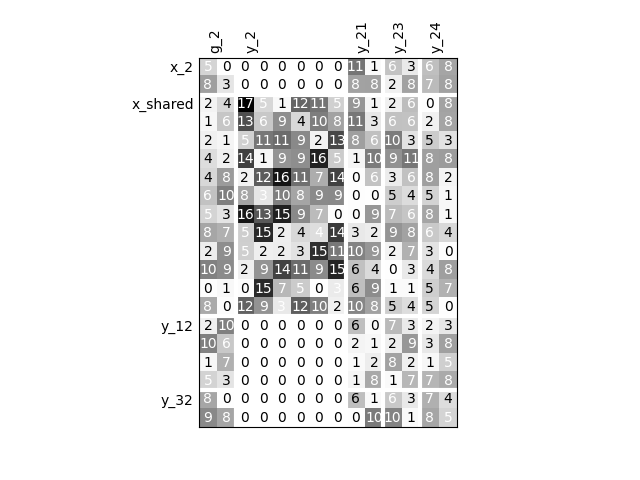
Total running time of the script: ( 0 minutes 5.650 seconds)

